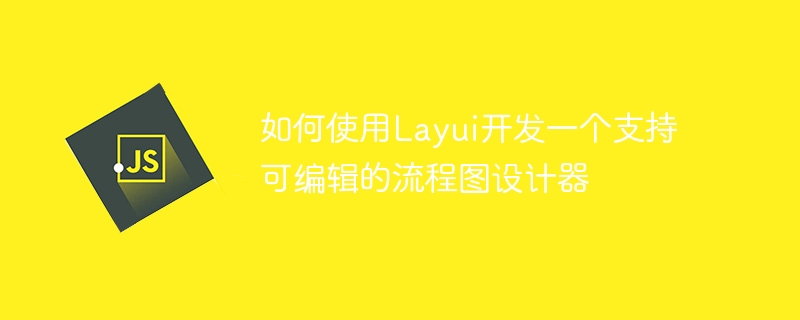
如何使用Layui开发一个支持可编辑的流程图设计器
引言:
随着信息化的快速发展,流程图在各行各业中的应用越来越广泛。然而,目前市面上流程图编辑器的选择较为有限,且大多数需要付费。本文将介绍如何使用Layui框架开发一个支持可编辑的流程图设计器,并提供具体的代码示例。
一、Layui简介:
Layui是一个简单易用的前端框架,提供了丰富的组件和接口,可以快速搭建Web界面。其特点是轻量、模块化、响应式等,非常适合快速开发简单的Web应用。
二、设计思路:
示例代码如下:
<div class="toolbar"> <button class="layui-btn layui-btn-primary" id="start">开始节点</button> <button class="layui-btn layui-btn-primary" id="process">流程节点</button> <button class="layui-btn layui-btn-primary" id="decision">决策节点</button> </div> <div id="canvas"></div>
示例代码如下:
layui.use(['jquery', 'layer'], function(){
var $ = layui.jquery;
var layer = layui.layer;
// 初始化工具栏按钮
$('#start').click(function(){
// 创建开始节点元素并在画布中显示
...
});
$('#process').click(function(){
// 创建流程节点元素并在画布中显示
...
});
$('#decision').click(function(){
// 创建决策节点元素并在画布中显示
...
});
// 初始化画布
var canvas = $('#canvas');
jsPlumb.ready(function(){
jsPlumb.setContainer(canvas);
...
});
});示例代码如下:
// 创建开始节点元素
var start = $('<div class="node start">开始</div>');
canvas.append(start);
jsPlumb.makeSource(start, {
filter: '.node',
anchor: 'Continuous',
connectorStyle: {
strokeStyle: '#999',
lineWidth: 2
},
connectionType: 'basic',
extract:{
"action":"the-action"
},
maxConnections: 1,
onMaxConnections: function(info, e) {
layer.msg("不能再添加连接了!", {time: 1000});
}
}).initDraggable();
// 创建流程节点元素
var process = $('<div class="node process">流程节点</div>');
canvas.append(process);
jsPlumb.makeSource(process, {
filter: '.node',
anchor: 'Continuous',
connectorStyle: {
strokeStyle: '#999',
lineWidth: 2
},
connectionType: 'basic',
extract:{
"action":"the-action"
},
maxConnections: -1,
onMaxConnections: function(info, e) {
layer.msg("不能再添加连接了!", {time: 1000});
}
}).initDraggable();
// 创建决策节点元素
var decision = $('<div class="node decision">决策节点</div>')
canvas.append(decision);
jsPlumb.makeSource(decision, {
filter: '.node',
anchor: 'Continuous',
connectorStyle: {
strokeStyle: '#999',
lineWidth: 2
},
connectionType: 'basic',
extract:{
"action":"the-action"
},
maxConnections: -1,
onMaxConnections: function(info, e) {
layer.msg("不能再添加连接了!", {time: 1000});
}
}).initDraggable();示例代码如下:
canvas.on('contextmenu', '.node', function(e){
e.preventDefault();
var node = $(this);
var menu = $('<div class="menu"></div>');
// 获取所有可连接的节点
var targets = canvas.find('.node').not(node);
// 创建菜单项
targets.each(function(){
var target = $(this);
var item = $('<div class="menu-item"></div>').text(target.text());
item.click(function(){
// 添加连接线
jsPlumb.connect({
source: node,
target: target,
... // 连接线的样式和属性设置
});
menu.remove();
});
menu.append(item);
});
// 显示菜单
menu.css({ top: e.pageY, left: e.pageX });
canvas.append(menu);
});三、总结:
本文介绍了如何使用Layui开发一个支持可编辑的流程图设计器。通过HTML和JavaScript代码示例,我们实现了工具栏的初始化、节点的拖拽和连接、节点之间的连接线等功能。读者可以根据需求进一步完善和扩展该流程图设计器。希望本文对于使用Layui进行流程图开发的读者有所帮助。
以上就是如何使用Layui开发一个支持可编辑的流程图设计器的详细内容,更多请关注php中文网其它相关文章!

每个人都需要一台速度更快、更稳定的 PC。随着时间的推移,垃圾文件、旧注册表数据和不必要的后台进程会占用资源并降低性能。幸运的是,许多工具可以让 Windows 保持平稳运行。

Copyright 2014-2025 https://www.php.cn/ All Rights Reserved | php.cn | 湘ICP备2023035733号